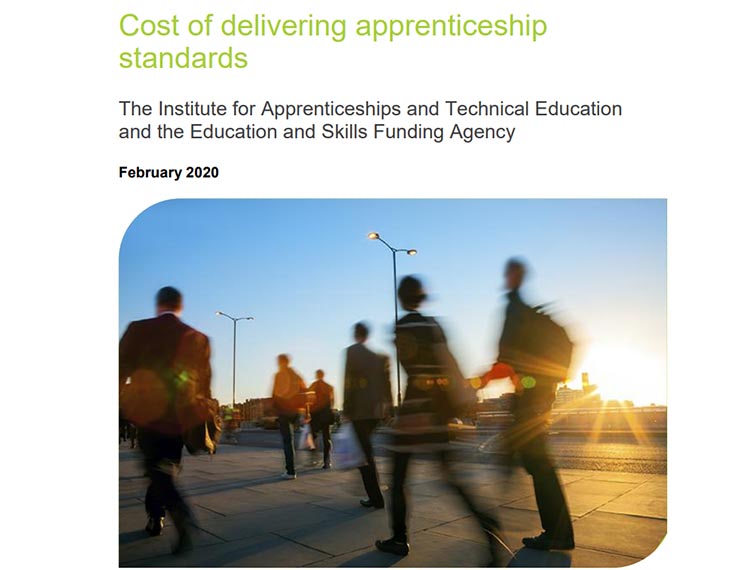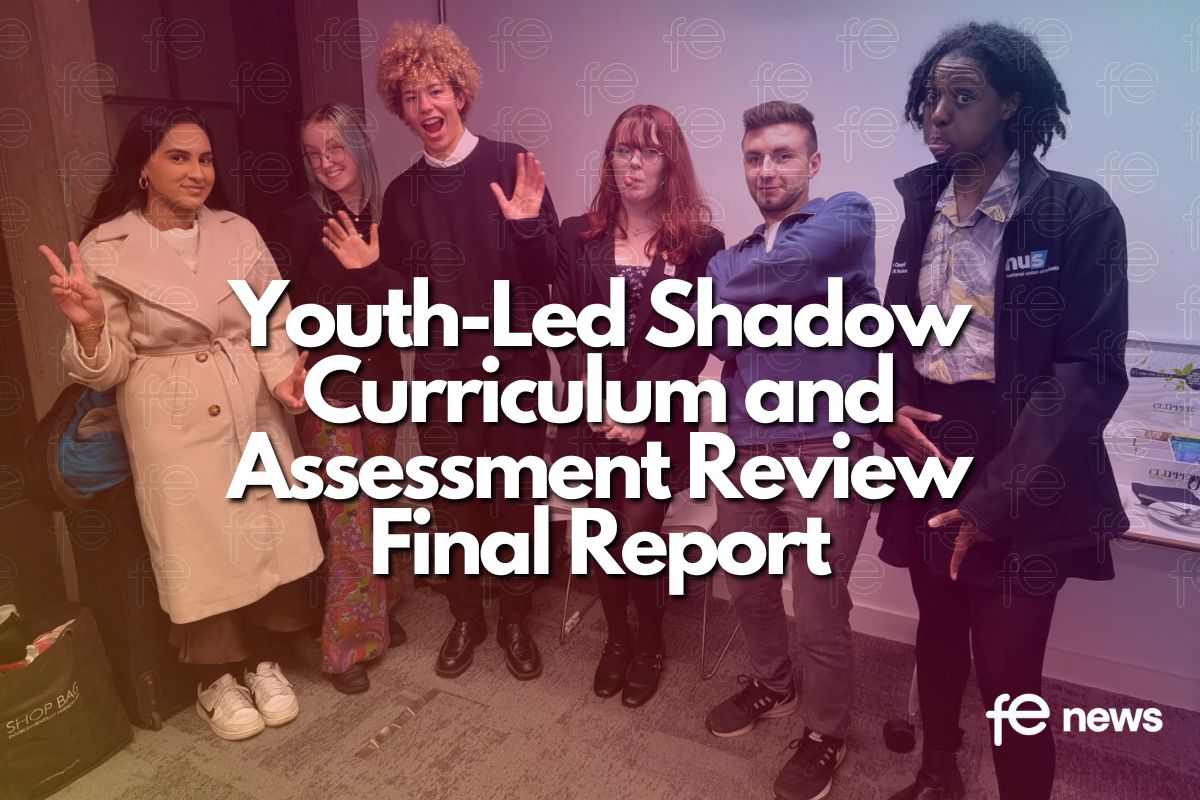The actual costs of delivering apprenticeships

“Costs of delivering apprenticeship standards” is a report for @IfATechEd by @IFFResearch Ltd. It looks at the costs of training and assessing apprentices undertaking apprenticeship standards in England.
The report was jointly commissioned in 2018 by the Institute for Apprenticeships and Technical Education and the Department for Education, and was contracted with the Institute.
The purpose was to add to the body of knowledge about apprenticeship standards and gain a better understanding of the costs of delivering apprenticeship training and assessment.
The research carried out in 2019 was designed to inform the work of both the Institute and the Department, including the design of a new approach to making funding band recommendations.
We have separately published information on this new approach, which is still in development, and you can tell us your views through our consultation process.
The IFF report captures a snapshot of the apprenticeships programme as it currently stands. Apprenticeship standards delivery is still in its early stages. For example, in some cases limited numbers of apprentices have progressed to their end point assessment. This is reflected in smaller sample sizes for some areas of the research. Those using the data should therefore treat findings appropriately, noting for example the specific data contexts outlined in the report.
The report has strengthened our evidence base on the costs of delivery. We expect to continue developing our evidence base as the apprenticeship standards training and assessment provider markets mature and develop over time.
Cost of delivering apprenticeship standards
The research aimed to provide the Institute for Apprenticeships and Technical Education (the Institute) and the Education and Skills Funding Agency (the ESFA) with more up to date and granular data to enable consideration of the individual costs associated with training and assessment.
The project’s overarching aim was to provide the Institute with robust evidence on the actual costs of training and end-point assessment (EPA) for apprenticeship standards.
More specifically, this research sought to understand:
- The typical cost of delivering apprenticeship standards across different levels and sectors;
- The granular detail of how costs are made up from different elements of training and assessment – for example tutor salaries, consumables, administration;
- The key factors or variables that produce a significant difference in either the overall or granular costs – for example type of standard, level, provider characteristics, cohort size; and
- Wider factors which may affect providers’ commercial decisions around offering apprenticeships.
To meet these aims, cost data was collected from all types of training provider across 54 apprenticeship standards across multiple routes and levels. Preliminary cost data was also gathered from end-point assessment organisations (EPAOs) across 17 apprenticeship standards. This data, alongside qualitative insights gathered from in-depth interviews, forms the basis of this report.
For EPAOs in particular, the data provides an initial view on the cost of EPA, with many EPAOs still in the early stages of EPA delivery and having delivered relatively low volumes of assessments at the time of fieldwork. Although the training provider market for standards is more developed, it is worth bearing in mind that some training providers had not yet reached a ‘steady state’ for delivery, with some still delivering apprenticeship frameworks alongside apprenticeship standards and some yet to have their first cohort complete on the standard being discussed.
Conclusions
The Institute and the DfE continue to develop their evidence base on the cost of apprenticeships, to inform funding band recommendations and policy. This research supports that aim by providing recent and granular data on the individual costs associated with training and assessment across 54 apprenticeship standards.
The project provides the Institute and the DfE with an important body of evidence and has sought to understand the typical costs of delivering apprenticeship standards across different levels and sectors. It has examined in detail how these costs break down across different elements of training and assessment, the key factors associated with significant differences in costs, and explored the wider factors that affect providers commercial decision-making.
As well as considering the costs incurred by providers delivering training for apprenticeship standards, the research also collected preliminary data from eight EPAOs on the costs of EPA across 17 standards. It is early days for the EPA market, which is still developing, and this data gives an initial view on the costs of EPA across a small number EPAOs. It also highlights the key commercial challenges and opportunities the EPA market is facing.
Across the 54 apprenticeship standards covered by the research, the overall mean cost per apprenticeship for delivering elements of the apprenticeship standard eligible for funding (‘eligible costs’), including the fee reported by training providers for the EPA, was £8,655 (the median was £7,058). Excluding the EPA fee, the mean total eligible cost was £7,101, and the median was £5,506.
Around this average, costs varied widely by a range of factors including the following (mean costs are shown, these exclude the fee charged for the EPA):
- Apprenticeship duration: from £3,881 where the duration was 12-17 months, to £14,295 where it was 48 months or longer;
- Level: from £5,371 for Level 2 apprenticeships to £17,466 for those at Level 6; and
- Route: for routes with at least 10 data points, from £3,597 for Business and Administration to £10,656 for Engineering and Manufacturing.
These factors interrelate – most clearly higher-level apprenticeships tend to be of longer duration. When looking at monthly mean costs per apprentice, excluding EPA fees, costs vary less widely. For example, the monthly mean cost for Level 2 apprenticeships was £274 and for Level 6 apprenticeships was £312 (it was highest at Level 4, at £371 per month). In the same way, the monthly mean cost for Business and Administration and Engineering and Manufacturing apprenticeships was broadly similar (£216 and £296 respectively; it was highest for Digital apprenticeships at £503 a month).
Costs varied by provider size, with larger providers (with 5,000 plus learners) reporting lower monthly mean costs (excluding EPA) per apprentice (£226 per month, 47% of the funding band on average) than providers with fewer than 5,000 learners (£309 per month, and equivalent to 73% of the funding band on average).
Statistical analysis shows that a number of factors were most closely correlated to higher overall costs of delivering an apprenticeship, including: longer duration apprenticeships, higher total number of teaching hours, and higher average salaries of those delivering training; while higher proportions of training time spent on supporting self-directed and distance learning or classroom training, and larger class sizes, were correlated with lower costs.
On average eligible costs (excluding the fee charged for EPA) were equivalent to twothirds (67%) of the funding band for the apprenticeship standards. Overall eligible costs generally increase with the funding band, but there was no clear pattern when looking at monthly eligible costs. EPA fees reported by training providers were equivalent to 13% of the funding band on average.
The largest share of eligible costs was made up of teaching costs (45%, and just over half these costs were for face-to-face delivery). The remainder of total eligible costs per learner split relatively evenly across the fee charged for EPA (18%), administration (17%), and assessment costs excluding EPA (14%); consumables comprised the smallest proportion (6%).
The findings suggest a complex interplay of factors drive costs with specific route/level/duration combinations coupled with the approach to teaching delivery (for example teaching method and class sizes) and teaching salaries coalescing to drive costs. By considering the particular features of a standard, the granular findings can be used to help understand why certain standards may incur higher or lower delivery costs.
Turning to EPAOs, cost data needs to be treated with caution both because of a relatively low number of interviews and the nascent stage of the market with most EPAOs having assessed relatively few apprentices and hence significant uncertainty about numbers and costs. With this note of caution in mind, the early findings from the market found a mean cost to EPAOs for each EPA, based on the numbers they expect to assess once the system is fully up and running, of £457 per learner, against a current mean fee charged of £1,121 (note that these figures are not directly comparable, as the current fee may reflect current higher delivery costs per EPA, rather than the cost based on anticipated numbers). Costs and fees varied quite widely, from costs of £178 to £1,037 per EPA.
Key to the success of the apprenticeship market is having a strong network of training providers to deliver standards across all routes and levels, and as such it is important to understand the commercial decision-making of providers when considering which standards to offer (or discontinue). Commercial decision-making tended to be a mix of the level of demand for a course (and how many employers and learners would be interested), the level of funding available and how that would relate to their anticipated costs of delivery, and their capacity/expertise to deliver the course.
Overall, training providers noted there was a risk attached to delivering apprenticeship standards and investing in new ones, and they had to manage this risk. As such they were cautious with respect to investments in new plant, machinery and equipment that might be expensive; subject to a degree of uncertainty relating to the level of funding available; they were open to providing new courses, but preferred to build upon existing delivery and expertise rather than branching into new subject areas; and were committed to delivering high quality training and therefore were reluctant to expose their organisations to any reputational and financial damage that would be caused if they were not delivering high quality training.
Similarly, the apprenticeship market relies on the development of a strong network of EPAOs offering EPA for apprenticeship standards at sufficient volumes and appropriate level of quality for the number of learners coming through. The market is in its infancy, and some EPAOs were still operating at a level where they had only conducted low volumes of EPAs, and were still recouping development costs. As with providers, EPAOs had a clear set of commercial considerations they bore in mind when deciding whether to offer an EPA for a particular standard (or indeed whether they continue to offer EPA for particular standards in the future). Overall EPAOs reported their commercial decision-making related to a mix of the opportunity to make a sufficient margin, there being sufficiently large volumes of learners to assess, the extent to which other EPAOs were offering particular EPAs, and there being a sufficient supply of assessors to carry out the assessments.
This technical report gives more detail about the data and design of the survey.











Responses